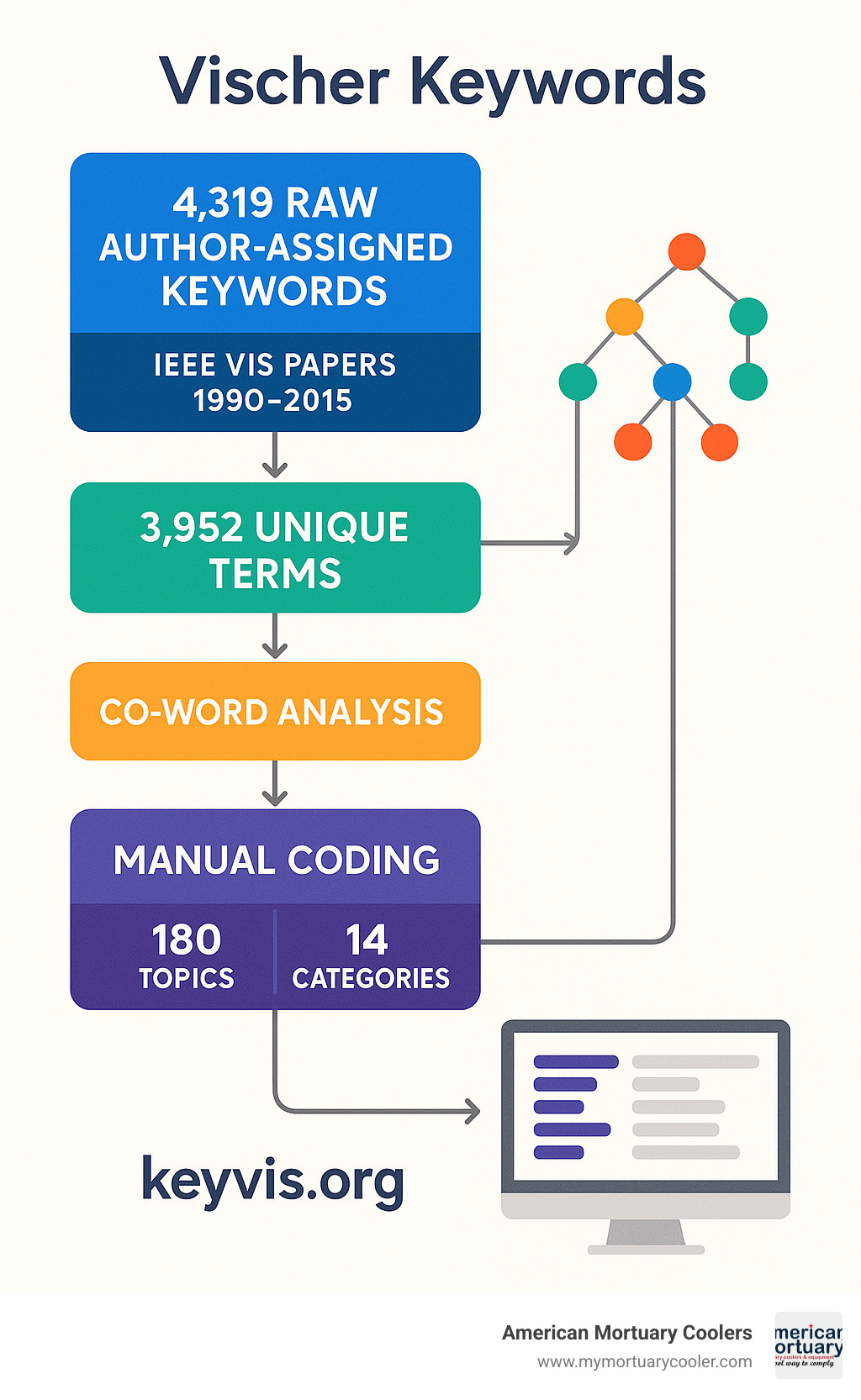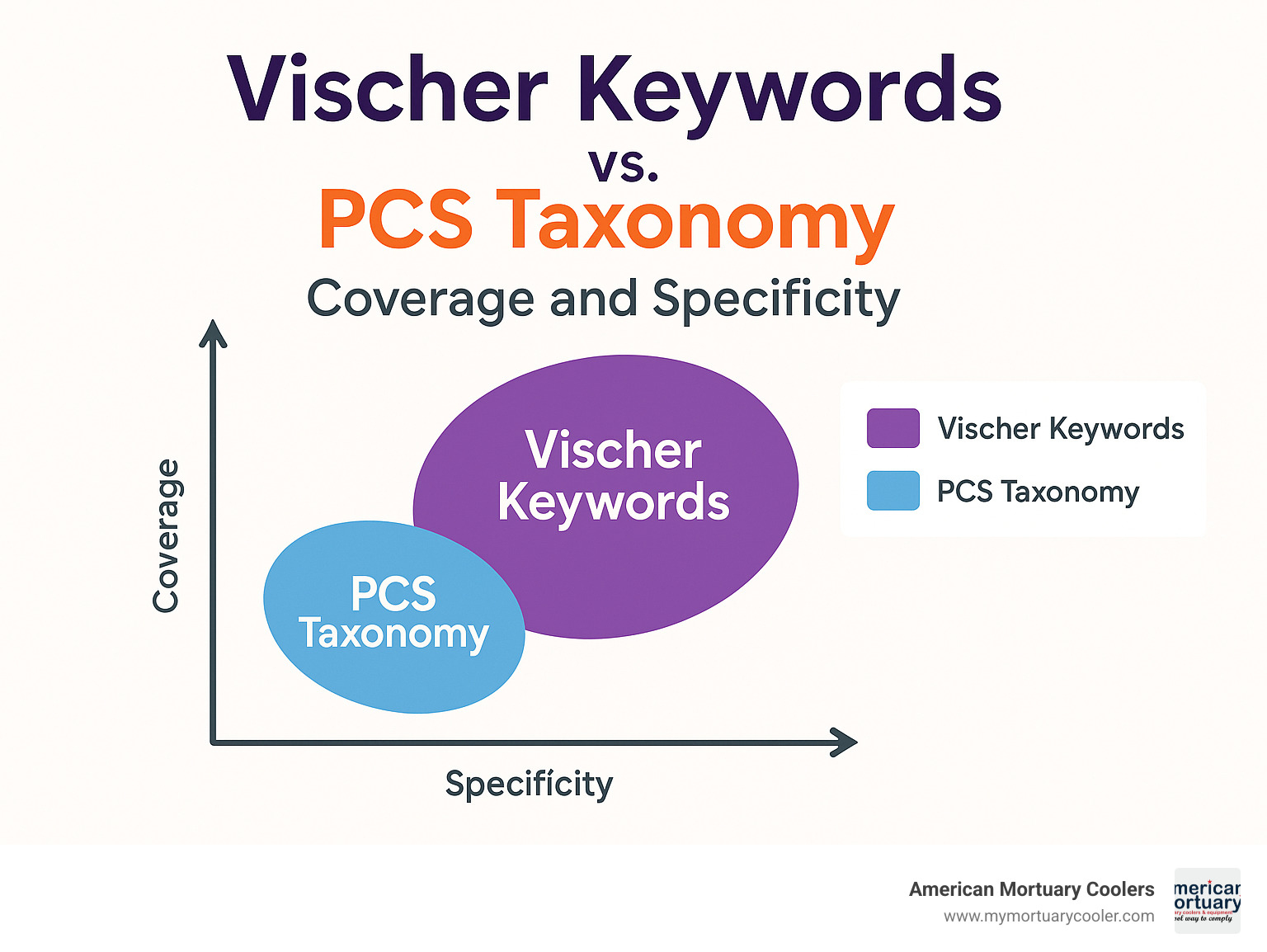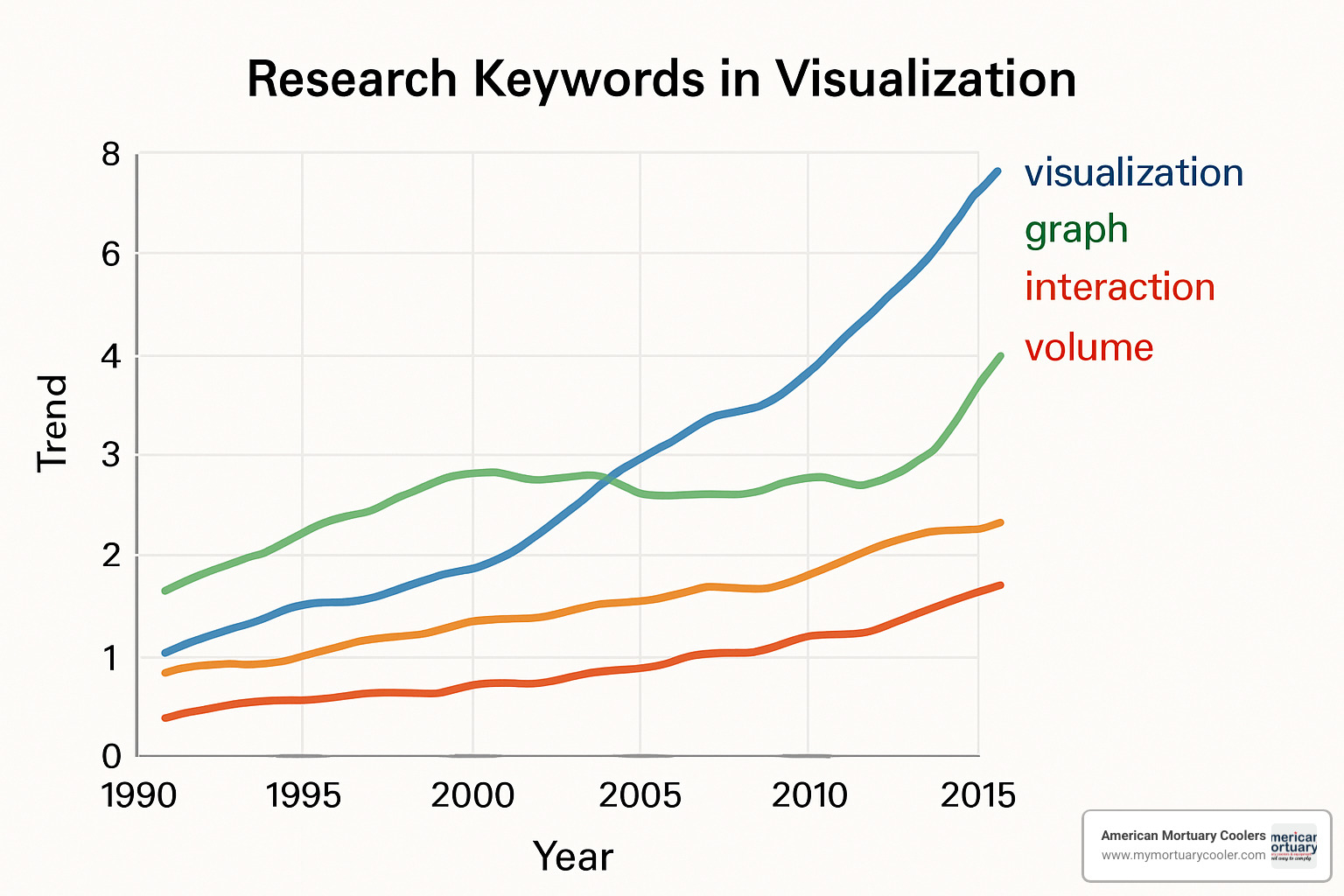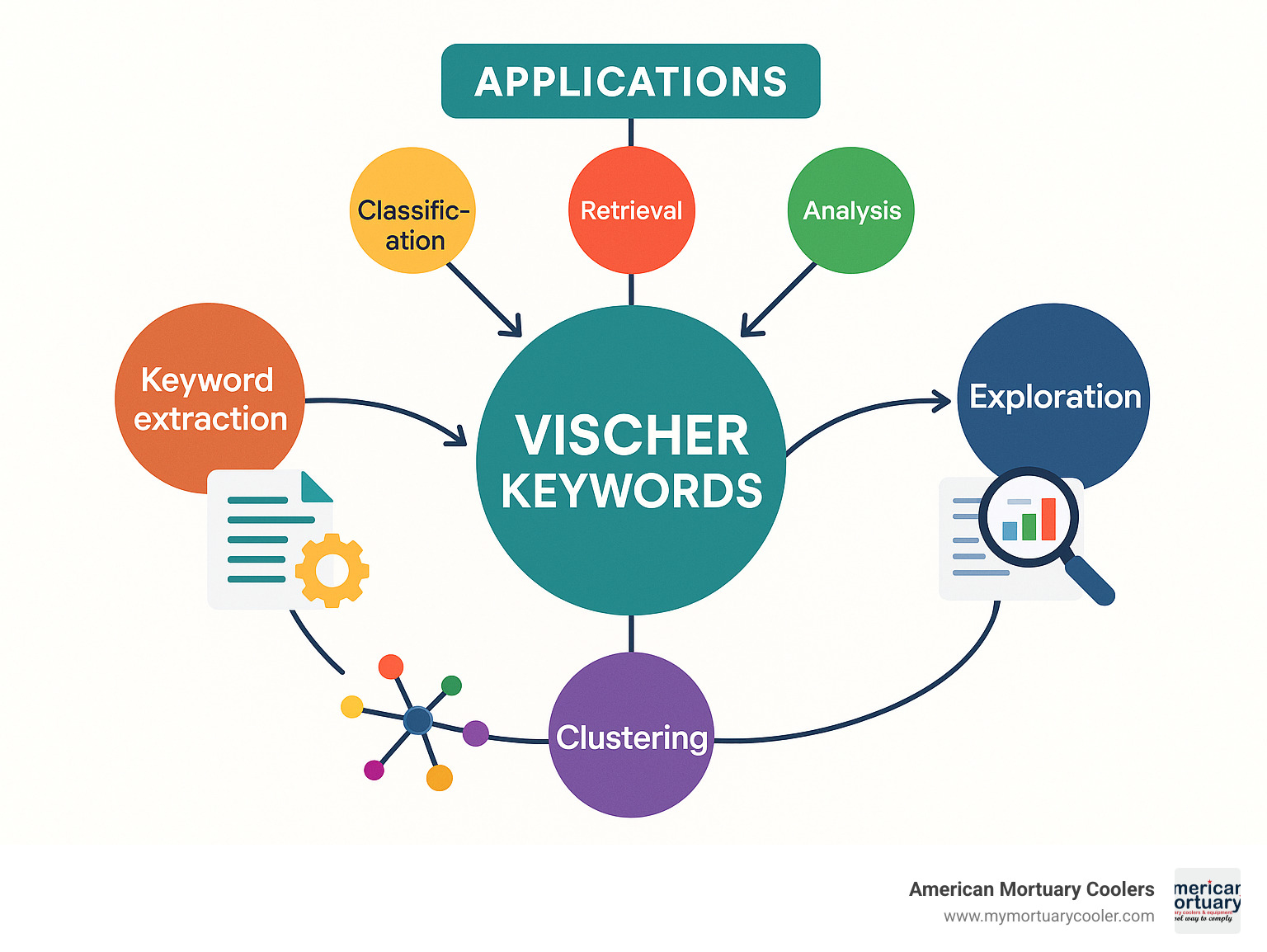Why Understanding Vischer Keywords Matters for Visualization Research
Vischer Keywords represent a groundbreaking approach to organizing and categorizing visualization research through author-assigned terms rather than top-down expert classifications. This taxonomy emerged from analyzing 3,952 unique keywords across 26 years of IEEE VIS papers, creating the first comprehensive, data-driven vocabulary for the visualization field.
Quick Answer: What are Vischer Keywords?
- Bottom-up taxonomy built from actual author-assigned keywords (1990-2015)
- 3,952 unique terms clustered into 180 topics across 14 categories
- Research navigation tool available at keyvis.org
- Alternative to PCS taxonomy with better coverage of emerging fields
- Co-word analysis method revealing natural research clusters
The visualization research community has long struggled with the question: "What is visualization?" As noted in the foundational research, "One of the main reasons why visualization is such a fascinating field of research is its diversity." This diversity, while exciting, created challenges for researchers trying to find relevant work, conference organizers matching reviewers, and newcomers understanding the field's scope.
Unlike traditional expert-created taxonomies, Vischer Keywords emerged organically from how researchers actually describe their own work. The analysis revealed fascinating insights - from 1990 to 2015, the most popular author-assigned keyword was "information visualization" (appearing in 136 papers), while the field evolved to encompass everything from data mining to human-computer interaction.
At American Mortuary Coolers, we understand the importance of systematic classification - whether organizing mortuary equipment across our locations in Johnson City TN, Atlanta GA, Chicago IL, and beyond, or helping researchers steer complex taxonomies. Our experience in data organization systems mirrors how Vischer Keywords help researchers efficiently categorize and find relevant work.

Vischer Keywords Fundamentals
Think of Vischer Keywords like a family recipe that evolved over generations - except instead of grandmothers adding their own touches, it's visualization researchers who shaped this taxonomy through decades of describing their own work. This isn't your typical expert-designed classification system where academics in ivory towers decide what categories should exist.

The magic happens through something called co-word analysis - a fancy term for a simple idea. When researchers repeatedly use certain keywords together in their papers, the system notices these patterns. If "information visualization" and "interaction" keep showing up as a pair, they're probably related concepts. It's like noticing that people who buy peanut butter usually grab jelly too.
This organic approach revealed natural research clusters that traditional taxonomies often missed completely. Instead of forcing square pegs into round holes, Vischer Keywords let the field show its true shape through 26 years of authentic researcher language.
Defining Vischer Keywords in Visualization Research
Vischer Keywords represent something genuinely groundbreaking in academic taxonomy - a classification system built entirely from the ground up using author-assigned terms rather than expert opinions. Picture it as the difference between a city that grew naturally over centuries versus one designed by urban planners on a blank sheet of paper.
The scope covers everything visualization researchers actually work on, from traditional scientific visualization to cutting-edge areas like visual analytics and human-computer interaction. This comprehensive coverage emerged from analyzing 1,575 IEEE VIS papers between 2000-2015 that included author keywords - representing about 90% of papers during this period.
That 90% adoption rate tells us something important. Visualization researchers genuinely accept keyword tagging, creating a robust foundation that most taxonomies can only dream of. When nearly every paper contributes to the vocabulary, you get a true picture of what the field really looks like.
The analysis revealed 16 major clusters from 116 high-frequency topics, showing both the incredible diversity of visualization research and its underlying organizational structure. It's like finding that a seemingly chaotic library actually has a logical system - you just needed the right lens to see it.
Origin and Purpose of the Vischer Keywords Taxonomy
The story behind Vischer Keywords starts with real problems that IEEE VIS organizers faced every year. Conference chairs struggled to match reviewers with papers in their expertise areas. Researchers spent hours hunting for related work across scattered publications. Newcomers felt overwhelmed trying to understand where their interests fit in the vast visualization landscape.
Traditional top-down taxonomies like the PCS (Physics and Astronomy Classification Scheme) kept missing the mark. They either overlooked emerging research areas entirely or forced unnatural categorizations that didn't reflect how researchers actually think about their work. It's like trying to organize a modern music collection using categories from the 1950s - some things just don't fit.
The bottom-up design process began with collecting 4,319 raw keywords from IEEE VIS papers spanning 1990-2015. But raw data is messy - researchers had to tackle spelling variations, plurals, and different ways of expressing the same concept. Terms like "information visualization," "InfoVis," and "information visualisation" all meant the same thing but appeared as separate entries.
After extensive cleaning and consolidation, the team arrived at 3,952 unique terms that truly captured the field's vocabulary. This cleaning process was crucial but painstaking - imagine sorting through thousands of business cards where everyone spelled their company name slightly differently.
The IEEE VIS roots provide both the taxonomy's greatest strength and its main limitation. While this foundation offers incredibly deep coverage of core visualization research, it might not fully represent work published in other major venues like CHI, SIGGRAPH, or domain-specific conferences. However, since IEEE VIS serves as the premier visualization conference, it makes an excellent starting point for understanding how the field talks about itself.
At American Mortuary Coolers, we appreciate the value of systematic organization - whether we're categorizing mortuary equipment across our locations or helping researchers steer complex classification systems. Just like Vischer Keywords emerged from real community needs, our solutions develop from understanding what funeral professionals actually require in their daily work.
Applying and Comparing Vischer Keywords
The real power of Vischer Keywords becomes clear when you see them in action. These aren't just academic terms sitting in a dusty database - they're actively helping researchers find papers, conference organizers match reviewers with submissions, and newcomers steer the complex world of visualization research.
The KeyVis tool brings this system to life. Think of it as Google for visualization research, but smarter. Instead of just matching words, it understands the relationships between concepts. When you search for "network visualization," it knows to also show you papers about "graph drawing" and "node-link diagrams" because researchers often use these terms together.
Conference organizers have found Vischer Keywords particularly valuable for reviewer matching. Instead of the old system where someone working on "scientific visualization" might review any visualization paper, organizers can now match papers about "volume rendering of medical data" with reviewers who actually publish work using those specific keyword combinations. It's like having a really smart matchmaker for academic papers.
The system organizes everything into 14 main categories that cover the full spectrum of visualization work. These categories emerged naturally from how researchers actually describe their work, rather than from some expert sitting in an ivory tower deciding how the field should be organized.
Selecting and Tagging Your Own Work
Choosing the right keywords for your research might seem straightforward, but there's definitely an art to it. The KeyVis tool is your best friend here - it shows you which keywords researchers actually use and how they combine them.
Start by exploring what's already out there. If you're working on interactive bar charts, see what keywords other researchers use for similar work. You might find that "coordinated views" or "brushing and linking" are common companion terms that better describe your contribution.
Balance is key when selecting keywords. You want terms that are specific enough to accurately describe your work but general enough that people can find it. If you only use super-specific terms like "radial node-link layouts for phylogenetic trees," you might miss researchers working on the broader problem of tree visualization.
Think about your audience too. Include application domain keywords if you want domain experts to find your work. A paper about visualizing gene expression data should probably include both "bioinformatics" and "heatmaps" to catch both visualization researchers and biologists.
The clustering patterns reveal some interesting insights. Papers about graph visualization almost always include keywords like "network analysis" and "layout algorithms." Understanding these natural groupings helps you choose keywords that work well together and position your research appropriately.
Main Categories & Clusters Inside Vischer Keywords
The beauty of Vischer Keywords lies in how they naturally organize into meaningful clusters. These 14 categories weren't imposed by experts - they emerged from analyzing how thousands of researchers actually describe their work over 26 years.
Interaction techniques form one of the largest clusters, which makes perfect sense when you think about it. Visualization has evolved from static charts to dynamic, interactive tools that let people explore data in real-time. Keywords in this cluster range from basic operations like "zooming" and "panning" to sophisticated techniques like "semantic zooming" and "focus+context."
Evaluation methods represent another major cluster that's grown significantly over time. The field has matured from "this visualization looks cool" to rigorous user studies and controlled experiments. Keywords here include everything from "usability testing" to "cognitive load" and "task performance."
Data types reveal just how diverse visualization has become. We're not just dealing with simple spreadsheets anymore - researchers work with social networks, text documents, streaming sensor data, and complex hierarchical structures. Each data type brings its own challenges and opportunities.
Application areas show visualization's incredible reach across disciplines. From helping doctors understand medical scans to helping historians explore cultural trends, visualization touches almost every field imaginable. This diversity is part of what makes the field so exciting and challenging to categorize.
Comparing Vischer Keywords to Other Taxonomies
The most important comparison is with the PCS taxonomy, which IEEE VIS has used for paper submissions since 2008. Both systems have their strengths, but they approach classification from completely different angles.

PCS is like a well-organized filing cabinet - everything has its place, and that place doesn't change much over time. Vischer Keywords are more like a living ecosystem that evolves as the field grows. When new research areas emerge, they naturally appear in the keyword data without waiting for expert committees to decide where they belong.
Vischer Keywords excel at capturing emerging trends. When visual analytics became a hot topic, it immediately showed up in author keywords. PCS took years to accommodate this new area because it required formal committee decisions and category restructuring.
However, PCS offers something Vischer Keywords can't match: stability. The categories don't shift around based on research trends, which makes long-term tracking easier. It's also more widely adopted across computer science venues, not just visualization conferences.
The consistency challenge is real. A paper might be classified differently in each system, and even within Vischer Keywords, authors might use different terms for the same concept. But this messiness also reflects the reality of how research actually works - it's not as neat and tidy as formal taxonomies suggest.
At American Mortuary Coolers, we understand the importance of both flexibility and consistency in classification systems. Whether we're organizing our inventory across locations in Johnson City TN, Atlanta GA, and Chicago IL, or helping researchers steer complex taxonomies, the key is choosing the right system for your specific needs. Sometimes you need the stability of traditional categories, and sometimes you need the flexibility to adapt to new developments.
Insights, Trends, Challenges & Future Directions
The Vischer Keywords analysis spanning 1990-2015 tells a fascinating story about how visualization research has evolved over 26 years. With 3,952 keywords serving as our data points, we can see exactly how researchers' thinking has shifted - almost like watching the field grow up before our eyes.

The numbers reveal dramatic shifts in research priorities. Some areas exploded in popularity while others quietly faded away. What makes this particularly interesting is that we're not just seeing what researchers studied, but how they thought about and described their work. It's like having a window into the collective mind of the visualization community.
The foundational research documented in Visualization as Seen Through its Research Paper Keywords established Vischer Keywords as a legitimate alternative to expert-created taxonomies. This work proved that bottom-up approaches could reveal insights that traditional classification systems missed.
At American Mortuary Coolers, we understand how important it is to track trends and adapt to changing needs. Just as we've evolved our mortuary cooler designs based on real customer feedback rather than assumptions, Vischer Keywords evolved from actual researcher behavior rather than expert guesswork.
Historical Trends and Emerging Topics
The keyword evolution reveals clear patterns in how visualization research has transformed. Information visualization dominated the early years, but the field has become much more diverse. Terms like visual analytics, interaction design, and human-computer interaction now appear alongside traditional visualization vocabulary.
Rising themes show where the field is heading. Visual analytics and data science integration reflect how visualization has become central to modern data analysis. Mobile and touch-based interaction keywords surged as smartphones and tablets changed how people interact with data. Collaborative visualization systems emerged as researchers recognized that data exploration often works better as a team activity.
Uncertainty visualization gained traction as researchers realized that showing what we don't know is just as important as showing what we do know. Machine learning applications in visualization represent the newest frontier, where artificial intelligence helps create better visualizations automatically.
Some themes have declined as the field matured. Traditional scientific visualization terminology appears less frequently, not because the work disappeared, but because it's now just one part of a much larger field. Desktop-only interaction paradigms gave way to multi-device approaches. Static visualization approaches lost ground to interactive systems that let users explore data dynamically.
The timing reveals something fascinating: new keywords often appear in papers years before they become mainstream research areas. Big data showed up in visualization papers before it became a buzzword everywhere else. Storytelling emerged as researchers began focusing on how to communicate insights, not just create pretty pictures.
Cross-domain influence appears clearly in the data. Terms from human-computer interaction, cognitive science, and data science increasingly appear alongside traditional visualization vocabulary. This reflects the field's growing recognition that good visualization requires understanding psychology, technology, and domain expertise.
Practical Benefits for Researchers and Practitioners
Vischer Keywords provide real-world benefits that go far beyond academic classification. The KeyVis tool helps researchers find papers they might never find through traditional searches. This proves especially valuable for interdisciplinary work where relevant research might use completely different terminology.
For literature findy, the keyword clusters reveal unexpected connections. A researcher studying network visualization might find relevant work in social media analysis or biological pathway visualization - areas they might never have explored otherwise.
Research framing becomes much more strategic with Vischer Keywords. Understanding which keyword combinations are common versus rare helps researchers position their work effectively. Crowded areas suggest competitive fields, while sparse combinations might indicate opportunities for novel contributions.
Conference organizers have found reviewer matching much more accurate using keyword-based expertise identification. Instead of matching a graph visualization paper with anyone who does information visualization, they can find reviewers who specifically work with network data and layout algorithms.
Funding agencies use Vischer Keywords analysis to understand research landscape evolution. The bottom-up nature reveals grassroots trends that expert panels might miss completely. When keywords like uncertainty visualization start appearing frequently, it signals an emerging area that deserves attention and support.
Limitations and Future Recommendations
Despite their advantages, Vischer Keywords aren't perfect. The IEEE VIS focus provides depth but limits breadth. While IEEE VIS is the premier visualization conference, important work also appears in CHI, SIGGRAPH, and domain-specific venues. Expanding the analysis would provide better coverage of the full visualization research landscape.
Overlap creates ongoing challenges. Similar concepts often use different terminology, making it hard to track true research trends. Maintenance requires constant attention as new terms emerge and existing ones evolve. Automation could help, but human oversight remains crucial for maintaining conceptual coherence.
The temporal drift problem affects all taxonomies. Terms that meant one thing in 1990 might mean something completely different today. Cross-domain terminology adds another layer of complexity - interaction means different things to visualization researchers versus user interface designers.
Future development should focus on hybrid approaches that combine Vischer Keywords' bottom-up insights with expert curation for stability. Regular updates every 3-5 years could capture evolving terminology while maintaining enough stability for practical use.
Natural language processing techniques might help identify synonym clusters and detect emerging terminology automatically. However, the human element remains essential - machines can spot patterns, but humans understand meaning and context.
The goal isn't perfect classification but useful organization. Vischer Keywords have already proven their value by revealing insights that traditional taxonomies missed. With continued refinement, they'll become even more valuable for understanding and navigating the rich landscape of visualization research.
Frequently Asked Questions About Vischer Keywords
The Vischer Keywords system often raises questions from researchers who are used to traditional classification methods. Let's address the most common concerns and clarify how this bottom-up approach works in practice.
What makes Vischer Keywords different from PCS taxonomy?
The fundamental difference lies in how these systems were created. Vischer Keywords grew organically from how researchers actually describe their own work, while PCS taxonomy was designed by domain experts using top-down categories.
Think of it like the difference between a path worn by walkers versus a sidewalk planned by city engineers. Vischer Keywords represent the natural paths researchers take when describing their work - they emerge from analyzing 3,952 terms that authors chose over 26 years of papers.
PCS taxonomy offers stability and clear hierarchy - once you learn the categories, they stay consistent. But this stability can be a limitation when new research areas emerge. Vischer Keywords excel at capturing emerging fields like visual analytics and human-centered design that traditional taxonomies often miss.
The coverage differences are significant. Vischer Keywords provide more granular terminology that reflects actual research practices, while PCS uses broader categories that sometimes force unnatural groupings. Many researchers now use both systems - choosing Vischer Keywords for literature searches and research positioning, while using PCS for stable administrative purposes.
How do I choose the right Vischer Keywords for my paper?
Selecting effective keywords starts with understanding the existing landscape. The KeyVis tool at keyvis.org shows you which terms researchers actually use and how they connect to each other. This exploration helps you avoid reinventing terminology that already exists.
Your keyword strategy should include both specific and general terms. Use precise methodological keywords like "node-link diagrams" alongside broader contextual terms like "network visualization." This combination helps different types of researchers find your work.
Application domain keywords are crucial if your work applies to specific fields. A paper about visualizing medical data should include both visualization methodology terms and medical informatics keywords. This dual tagging helps domain experts find your work even if they don't typically read visualization literature.
The clustering analysis reveals which keywords frequently appear together. If you're working on graph visualization, you'll likely want terms like "layout algorithms," "network analysis," and possibly "interaction techniques." Understanding these natural groupings helps you select complementary keywords that accurately position your research.
Avoid overly generic terms that don't distinguish your work. Keywords like "computer graphics" or "data analysis" are so broad they don't help readers understand what makes your research unique. Focus on terms that genuinely describe your specific contributions.
Are Vischer Keywords still evolving with new research areas?
The original Vischer Keywords analysis covered papers from 1990 to 2015, which means recent developments aren't yet reflected in the taxonomy. Major trends like AI-assisted visualization, virtual and augmented reality applications, and pandemic-related visualization research have emerged since then.
However, the beauty of the bottom-up approach is that it can easily incorporate new terminology. The same methodology that created the original taxonomy could be reapplied to recent papers, capturing how researchers describe these emerging areas.
Current gaps include terminology around machine learning integration, immersive analytics, and collaborative remote visualization - all areas that have exploded since 2015. The visualization community has also acceptd new application domains like climate science communication and social justice data visualization.
The research community has discussed updating the analysis to include recent IEEE VIS papers plus work from other major venues like CHI and SIGGRAPH. This expansion would provide more comprehensive coverage while maintaining the organic, author-driven approach that makes Vischer Keywords so valuable.
Until formal updates occur, researchers working in newer areas might need to supplement Vischer Keywords with contemporary terminology. The existing framework still provides excellent coverage for core visualization concepts, even as the field continues expanding into exciting new directions.
Conclusion & Next Steps

Vischer Keywords have changed how we think about organizing visualization research. Instead of experts deciding what categories should exist, this system grew naturally from how researchers actually describe their own work over 26 years. It's like watching a garden grow rather than building a fence - the results reflect what actually happens in the field.
The numbers tell an impressive story: 3,952 unique keywords analyzed across more than two decades of research. This isn't just data - it's a living record of how visualization evolved from basic scientific charts to today's interactive systems that help us understand everything from social networks to climate change.
At American Mortuary Coolers, we see similar patterns in our own field. Just as Vischer Keywords reveal the natural structure of research topics, our experience organizing mortuary equipment across locations from Johnson City TN to Los Angeles shows how proper classification makes everything work better. Whether we're categorizing cooling systems for funeral homes or researchers are tagging papers about data visualization, good organization makes the difference between confusion and clarity.
The continued refinement of this visualization vocabulary matters more than ever. New research areas pop up constantly - think about how virtual reality, artificial intelligence, and mobile devices have transformed what's possible. The Vischer Keywords system provides a foundation, but it needs regular updates to stay useful as the field keeps growing.
For anyone just starting in visualization research, these keywords offer both a roadmap and a findy tool. The KeyVis platform lets you explore connections between research areas that you might never find through regular searching. It's like having a knowledgeable friend who can point you toward related work you didn't know existed.
The future looks bright for this approach. Expanding beyond IEEE VIS papers, adding recent research developments, and mixing bottom-up insights with expert guidance could make the system even more powerful. The goal remains simple: create a vocabulary that actually helps the entire visualization community communicate and collaborate better.
Whether you're positioning new research, organizing conference reviews, or trying to understand where your work fits in the bigger picture, Vischer Keywords provide practical tools that work. The system proves that sometimes the best way to organize knowledge is to listen to how people naturally talk about their work rather than forcing artificial categories.
The visualization field keeps expanding in exciting directions, and having good tools to steer that growth benefits everyone. From seasoned researchers to curious newcomers, Vischer Keywords help make sense of a complex and rapidly evolving landscape.
For those interested in learning more about systematic organization principles that work across different industries, explore our comprehensive mortuary cooler solutions that demonstrate similar approaches to careful categorization and efficient organization in the funeral industry.


















